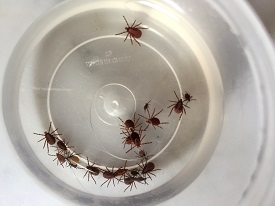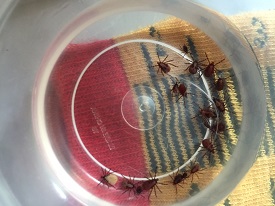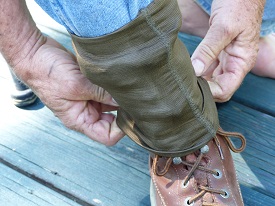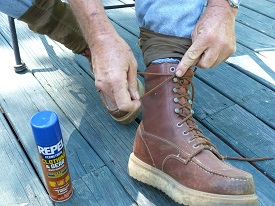We are proud of and fortunate that our yard is home to a wide array of fascinating plants and wildlife.

Only a good friend would know that we want pictures of creepy crawlies and save them for us for our blog!
But, last year Rich encountered a wild animal that he wishes he’d avoided. A deer tick found and bit him, although he never saw the tiny eight legged creature. A classic symptom of Lyme Disease is a red rash shaped like a bull’s eye. But Rich never had one. Instead he became overwhelmed with lethargy.
“I never felt sick, just tired, and kept thinking I’d be fine in a day or two,” he said.
But the fatigue dragged on for months, so he called our family physician who urged him to come right in. She gave him a thorough check over, and prescribed a chest X Ray and a Lyme Disease blood test.
Rich did both that afternoon. Within hours the doctor called to say the X ray revealed pneumonia and prescribed an antibiotic. Four days later the Lyme test came back positive and she prescribed a 21 day regime of amoxicillin, a different antibiotic.
“In just a few days the medicine worked and I felt better. Within a month the fatigue evaporated and the only lingering symptom was mild knee pain that may or may not have been caused by Lyme. I’m 66 and have a bit of osteo arthritis,” he said.
Rich was lucky. A year after the Lyme diagnosis he’s doing fine. Fortunately, his doctor prescribed the correct tests and medication and caught the disease early. Many people are less fortunate and suffer long term pain, fatigue and other symptoms.

Ticks measured against eighth inch markings.
Lyme disease is transmitted by the deer tick, a tiny eight legged animal that is increasingly common. Ticks live in tall grass and brushy areas, and our yard at Winding Pathways has both. We walk through other places where a tick could have found Rich. Ticks usually crawl around on a person for several hours before digging through the skin and feeding on blood. A wandering tick that has not penetrated the skin cannot transmit disease. Pluck it off and flush it down the toilet or drop it into soapy water.
It’s easy to be scared by negative publicity about Lyme Disease and stay inside. While the disease is serious and is not to be taken lightly, advice to avoid brushy and grassy places must be put into context. These places are beautiful and are homes to interesting wildlife and plants. They are places to get exercise. Even after contracting Lyme we spend part of our time in tick habitat, but we are cautious.

Gaiters fit snugly over boots and pants to deter ticks.
Here’s what we now do:
- Spray our clothes, ankles, and wrists with insect repellent containing DEET.
- When outside for a while we don special tick resistant gaiters (sometimes called spats) that make it hard for a tick to get under pants legs. We bought them from Forestry Suppliers for $13.

Permethrin-based spray can be bought at most stores that sell insect repellent.
We spray the gaiters with special repellent containing Permethrin that both repels and kills ticks Apply this to clothing, not skin. It is effective for at least two weeks so we don’t launder the gaiters but reapply the spray a couple of times a month.
- Change and launder clothes and shower when we’re done outside. Tiny deer ticks are tough to spot, but we do a body tick check as part of showering.
- Pay attention to our bodies. If we spot a dug-in tick or bulls-eye rash or experience lethargy or joint pain we’ll get to our doctor right away. No procrastination.
Rich emerged from Lyme Disease cautious and smarter but not afraid of being outside in beautiful and interesting places.
FOR MORE INFORMATION
The Internet has great information on ticks and Lyme Disease.
Two of our favorite information sites are:
Centers for Disease Control and Prevention.
WebMD type in the search bar Lyme Disease.
We ordered our tick and chigger gaiters from Forestry Suppliers.
Permethrin based spray can usually be purchased in stores that sell insect repellent. Be sure to read the label.

